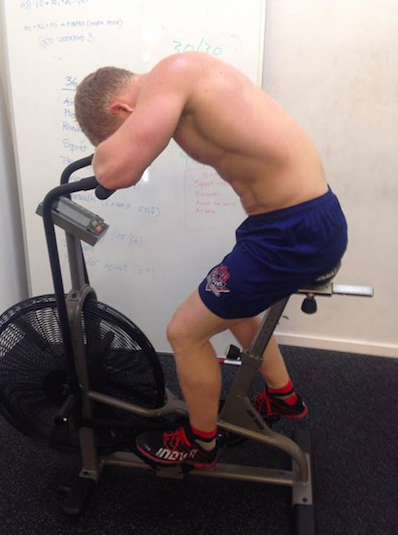TABATA er efterhånden en af de mest misforstået træningstilgange i branchen. Trænere sætter dem konstant på programmer, smider videoer på youtube og snakker om TABATA. TABATA Squat, TABATA swings, TABATA sit-ups, TABATA lort….
TABATA
Meget få kender til forskningen der er lavet på TABATA. En TABATA er IKKE blot 8 runder af 20 sekunders arbjede / 10 sekunders pause.
Forskningen er lavet af Izumi Tabata i 1996. Den blev udført på stationære cykler og gik ud på at undersøge forbedring i den anaerobe kapasitet iforhold til almindelig aerob træning på cykel. De fandt en fremgang i den anaerobe kapasitet i gruppen der udførste TABATA (4x ugentligt).
“For group 2, both the anaerobic capacity and VO2 max showed improvements. VO2 max improved in the interval group from 48 ml/kg/min to roughly 55 ml/kg/min (see graphic below). It is worth noting that the interval group was starting with a lower value and may have had more room for improvement. Also note that they still ended up with a lower Vo2 max than the steady state group.”
De fandt også en fremgang for gruppen der udførste aerob træning (4x ugentligt):
“For group 1, the standard aerobic training group, while there was no increase in anaerobic capacity, VO2 max increased significantly from roughly 52 to 57 ml/kg/min (I say roughly because the paper failed to provide vaules, I’m going by what’s in the graphic below). Frankly, given the lack of anaerobic contribution to steady state training, the lack of improvement in this parameter is absolutely no surprise.”
Det interessante er hvordan TABATA blev udført for at få denne fremgang, og hvordan coaches nu om dage bruger TABATA for at opnå fedtforbrænding via EPOC (Efterforbrænding).
“The second group performed the Tabata protocol. For four days per week they performed 7-8 sets of 20 seconds at 170% of VO2 max with 10 seconds rest between bouts, again this was done after a 10 minute warm-up. When more than 9 sets could be completed, the wattage was increased by 11 watts. If the subjects could not maintain a cadence of 85RPM, the workout was ended.”
For at udføre en TABATA og opnå den ønskede efterforbrænding er der altså et par krav:
1 – 7-8 runder af 20 sekunders arbejde / 10 sekunders pause.
2 – VO2max skal ligge på 170%
3 – 85RPM er mindste krav
Hvis disse krav ikke blev opfyldt talte dataen ikke i studiet.
Jeg ser INGEN klienter der kan holde disse krav! Dermed opnåes der IKKE den store efterforbrænding som TABATA-studiet viste, og dermed er TABATA måske ikke det mest optimale for klienter der ønsker varigt fedttab.
“My VO2 max occurs somewhere between 300-330watts on my power bike, I can usually handle that for repeat sets of 3 minutes and maybe 1 all out-set of 5-8 minutes if I’m willing to really suffer. That’s how hard it is, it’s a maximal effort across that time span.
For a proper Tabata workout, 170% of that wattage would be 510 watts (for perspective, Tour De France cyclists may maintain 400 watts for an hour). This is an absolutely grueling workload. I suspect that most reading this, unless they are a trained cyclist, couldn’t turn the pedals at that wattage, that’s how much resistance there is.”
Kilder:
Tabata, Izumi; Nishimura, Kouji; Kouzaki, Motoki; Hirai, Yuusuke; Ogita, Futoshi; Miyachi, Motohiko; Yamamoto, Kaoru (1996). “Effects of moderate-intensity endurance and high-intensity intermittent training on anaerobic capacity and VO2max”. Medicine & Science in Sports & Exercise 28






